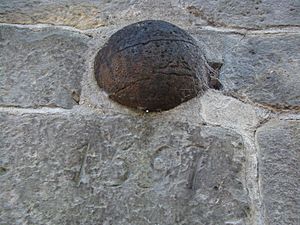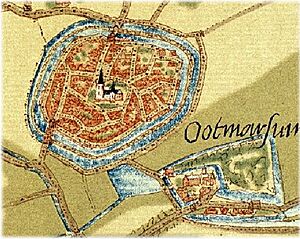Capture of Ootmarsum facts for kids
Quick facts for kids Capture of Ootmarsum (1597) |
|||||||
|---|---|---|---|---|---|---|---|
| Part of the Eighty Years' War & the Anglo–Spanish War | |||||||
 Cannonball from the siege lodged in the church in Ootmarsum today |
|||||||
|
|||||||
| Belligerents | |||||||
| Commanders and leaders | |||||||
| Strength | |||||||
| 2,800 | 120 | ||||||
| Casualties and losses | |||||||
| Unknown (light) | All captured | ||||||
The Capture of Ootmarsum in 1597 was a quick battle during two big wars: the Eighty Years' War and the Anglo–Spanish War. A Dutch and English army, led by Count Van Duivenvoorde, attacked the town. This happened while Maurice of Nassau was busy attacking another town called Oldenzaal.
The fight for Ootmarsum lasted only three days, from October 19 to 21. The Spanish soldiers defending Ootmarsum, led by Governor Otto Van Den Sande, gave up. The Dutch and English forces then took control of the town. This victory was part of a very successful plan by Maurice of Nassau against the Spanish that year.
After the capture of Enschede, Maurice of Nassau and his army moved towards Oldenzaal. But before reaching Oldenzaal, Maurice decided to split his army. He sent a group led by Count Van Duivenvoorde to Ootmarsum. Their mission was to make Ootmarsum surrender to the Dutch.
The Fight for Ootmarsum
The attack on Ootmarsum started much like the one on Enschede. A Dutch trumpeter, carrying a white flag to show peace, was sent to the gate of Ootmarsum. He demanded that the town surrender. Count Duivenvoorde warned that if they didn't give up, his army would destroy Ootmarsum. He reminded them of what happened to Bredevoort and Groenlo just weeks before.
The Spanish commander, Otto van den Sande, replied that King Philip II had ordered him to fight. He said he could not surrender because only someone with higher power could make that choice. Sande then ordered his cannons to fire non-stop from the town walls. This continued all night, causing some injuries among the English soldiers who were digging trenches.

When Maurice of Nassau heard about the strong resistance, he sent four heavy cannons to Ootmarsum. The next evening, Dutch engineers began to dig closer to the town's southern walls. They spent that time setting up two large siege cannons. On the north side, English soldiers and engineers did the same. They brought three artillery cannons into position.
Inside Ootmarsum, the defenders soon noticed these new digging works. They started firing their cannons again, aiming at these new positions.
Otto van den Sande quickly realized that his situation was hopeless. There was no chance of help arriving for his soldiers. He asked for Maurice's written terms for surrender. This time, the surrender happened right away. The Spanish and German soldiers, about 120 men, left the city. They were allowed to take two flags, two cannons, and some supplies like gunpowder and flour.
The agreement stated that the soldiers had to stay behind the Meuse River for three months. During this time, they were not allowed to fight. Dutch and English troops then took over Ootmarsum. Count Van Duivenvoorde ordered that the town's defenses and outer moat be torn down. This was similar to what happened in Enschede. At the same time, Maurice of Nassau and his main army were busy attacking Oldenzaal, which also surrendered a day later.
Images for kids
See also
- List of stadtholders in the Low Countries
- List of governors of the Spanish Netherlands
- Siege of Bredevoort (1597)
- Siege of Groenlo (1597)


